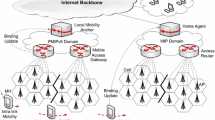Abstract
The basic reason of handover is to stay connected to the Internet with the intention of reducing connection quality deterioration. In a ubiquitous network, mobile nodes often perform handovers to stay connected to the Internet. These mobile nodes sometimes suffer from performance degradation during handover due to radio interference and reduction of signal strength. Therefore, we identified two goals in our paper. The first goal of this paper is to prove that trend based handover triggering mechanisms are better indicators of link going down as compared to threshold based handover triggering mechanisms. The second goal of this paper is to propose our idea of using frame retransmission trend in triggering handovers in order to achieve improved communication quality performance. In our work, we compared signal strength and frame retransmission as the handover decision criterion by means of simulations. Finally we present the effectiveness of our proposed frame retransmission trend as the handover decision criterion to achieve improved communication quality.
Similar content being viewed by others
References
Tsukamoto K., Yamaguchi T., Kashihara S., Oie Y. (2007) Experimental evaluation of decision criteria for WLAN handover: Signal strength and frame retransmission. The Institute of Electronics, Information and Communication Engineers (IEICE) Transactions 90-B(12): 3579–3590
Mhatre, V., & Propagiannaki, K. (2006). Using smart triggers for improved user performance in 802.11 wireless networks. In Proceedings of the 4th international conference on mobile systems, applications and services (pp. 246–259).
Shin, S., Forte, A. G., & Schulzrinne, H. (2006). Seamless layer-2 handoff using two radios in IEEE802.11 wireless networks. Columbia University Technical Report CUCS-018-06.
Berk, V., Mishra, A., & Banerjee, S. (2005). Eliminating handoff latencies in 802.11 WLANs using multiple radios: Application, experience and evaluation. In Proceedings of the 5th ACM SIGCOMM conference on internet measurement (pp. 299–304).
Bell Communications Research Inc: (1996) Trends in handover design. IEEE Communications Magazine 34(3): 82–90
Liu M., Li Z.-C., Guo X.-B. (2007) An efficient handoff decision algorithm for vertical handoff between WWAN and WLAN. Journal of Computer Science and Technology 22(1): 102–108
Marcsh, I., Gronvall, B., & Hammer, F. (2006). The design and implementation of a quality-based handover trigger. In Proceedings of networking (pp. 580–591).
Chuah, C. N., Yates, R. D., & Goodman, D. J. (1995). Integrated dynamic radio resource management. In Proceedings of IEEE 45th vehicular technology conference (pp. 584–588).
Kashihara, S., & Oie, Y. (2005). Handover management based on the number of retries for VoIP on WLANs. In Proceedings of IEEE 61st vehicular technology conference (pp. 2201–2206).
Tanaeka, Y., Kashihara, S., Tsukamoto, K., Yamaguchi, S., & Oie, Y. (2007). Terminal-centric AP selection algorithm based on frame retransmission. In Proceedings of 2nd ACM workshop on performance monitoring and measurement of heterogeneous wireless and wired networks (pp. 128–131).
Tsukamoto K., Kashihara S., Oie Y. (2008) A unified handover management scheme based on frame retransmission for TCP over WLANs. The Institute of Electronics, Information and Communication Engineers (IEICE) Transactions E91-B(4): 1034–1046
Yousaf, F. Z., Bauer, C., & Wietfeld, C. (2008). An accurate and extensible mobile IPv6 (xMIPv6) simulation model for Omnet++. In Proceedings of 1st international conference on, simulation tools and techniques communication, networks and systems & workshops.
Bill R., Cap C., Kofahl M., Mundt M. (2004) Indoor and outdoor positioning in mobile environments-a review and some investigation on WLAN positioning. Annals of GIS 10(2): 91–98
Lang, V., & Gu, C. (2005). A location method for WLAN based location service. In Proceedings of the IEEE international conference on E-business engineering (pp. 427–431).
Woon, S., Golmie, N., & Sekercioglu, Y. A. (2006) Effective link triggers to improve handover performance. In Proceedings of personal, indoor and mobile radio communications (pp. 1–5).
Author information
Authors and Affiliations
Corresponding author
Rights and permissions
About this article
Cite this article
Lim, J.MY., Chow, CO. & Ishii, H. Handover Trigger Based on Frame Retransmission Trend in Mobile IPv6. Wireless Pers Commun 70, 41–56 (2013). https://doi.org/10.1007/s11277-012-0677-4
Published:
Issue Date:
DOI: https://doi.org/10.1007/s11277-012-0677-4




